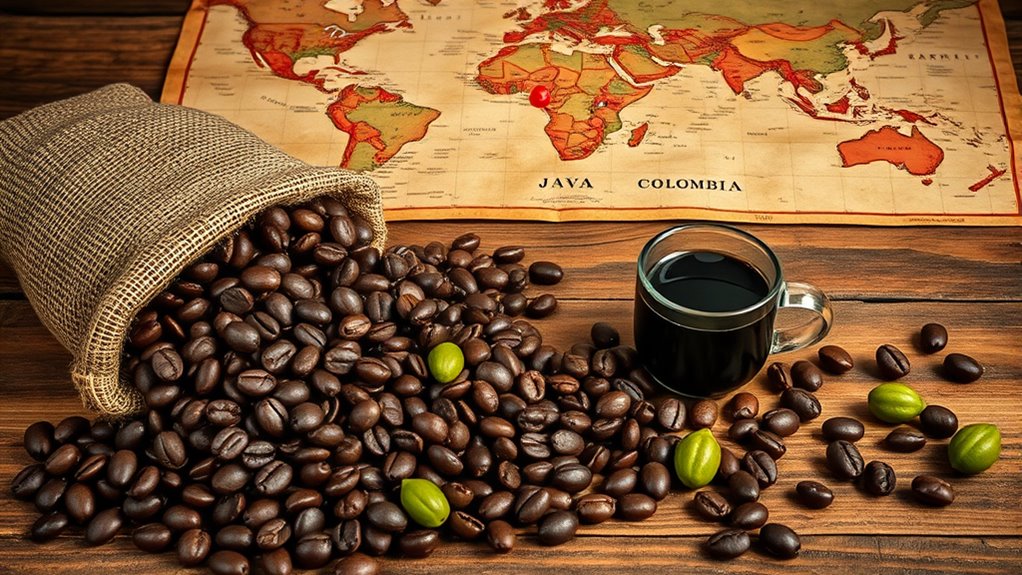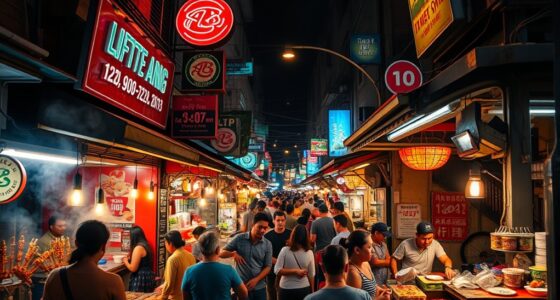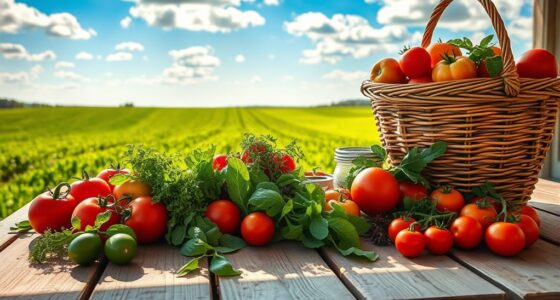On your coffee journey from Java to Colombia, you’ll explore how colonial histories shaped local plantations and traditions. You’ll witness Southeast Asia’s volcanic soils and mountain terraces that influence rich, spicy flavors, alongside South America’s high-altitude farms producing smooth Arabicas. As you go, discover how climate challenges lead to sustainable farming with shade trees and resilient varieties. If you want to uncover how these regions’ unique landscapes and cultures create timeless brews, continue exploring this vibrant coffee trail.
Key Takeaways
- Java’s coffee history is rooted in Dutch colonial trade, fueling regional and global markets for centuries.
- Colombia’s high-altitude regions produce premium Arabica beans with distinctive, sweet flavor profiles.
- Volcanic soils and microclimates in Southeast Asia and South America shape unique coffee characteristics.
- Coffee industry dynamics include port hubs like Santos and Buenaventura, facilitating global distribution.
- Cultural rituals and festivals celebrate local heritage, fostering community identity from Java to Colombia.
The Historic Roots of Coffee Cultivation in Java and Colombia
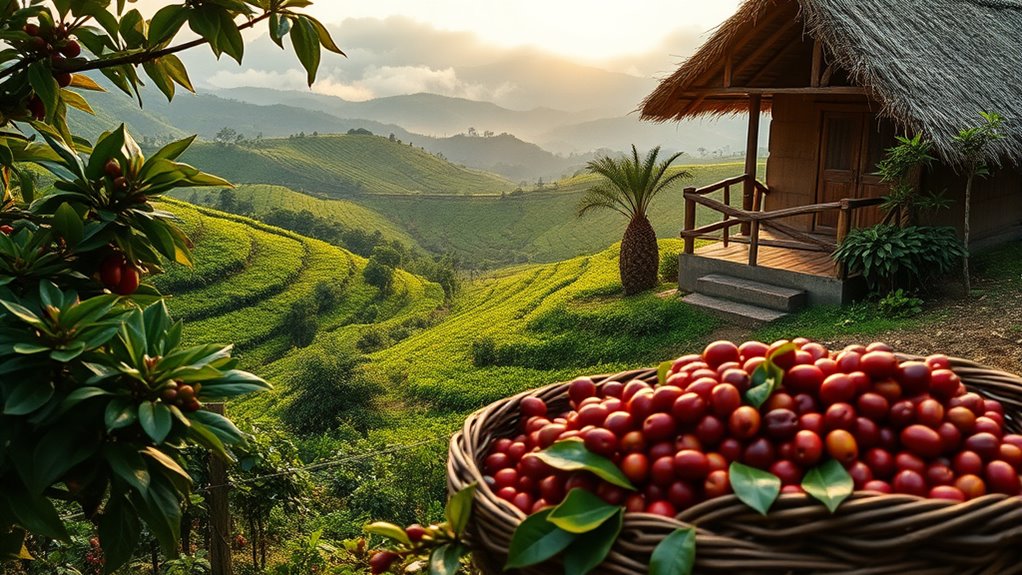
The roots of coffee cultivation in Java and Colombia reveal a history shaped by colonial influence and adaptation to local environments. In Java, Dutch colonizers introduced coffee in the late 1600s, using colonial methods that controlled planting, harvesting, and export through the VOC. These historical cultivation methods aimed to meet Europe’s high demand for coffee, turning Java into a major global supplier. The colonial economic impact was profound, as coffee exports fueled the Dutch empire’s wealth, with ports like Batavia serving as key hubs. Similarly, in Colombia, coffee was introduced in the early 18th century and expanded in the 19th century, driven by favorable Andean climates. Both regions’ coffee histories reflect colonial strategies that shaped their economies and the legacy of coffee as an essential commodity.
Geographic Features Shaping Coffee Landscapes in Southeast Asia and South America
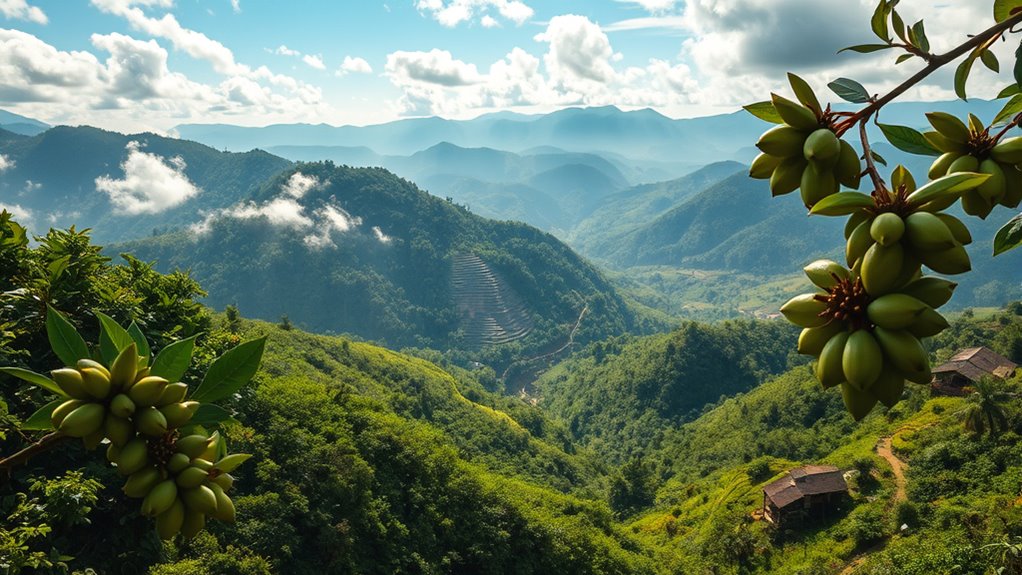
Understanding how geographic features influence coffee landscapes reveals why Southeast Asia and South America produce such diverse and distinctive coffee varieties. In Southeast Asia, mountain terraces are common, especially in Indonesia and Vietnam, where high elevations allow beans to develop complex flavors. Volcanic soils enrich these regions, providing essential nutrients that boost plant health and flavor complexity. For example, volcanic ash in Sumatra and Sulawesi creates fertile ground, resulting in earthy, spicy profiles. These terrains interact with climate conditions, producing unique environments for coffee cultivation. Additionally, the presence of mountainous terrain in these regions helps create microclimates that further influence the taste profiles of the beans. Meanwhile, in South America, rugged mountainous terrain—like Colombia’s highlands—offers similar benefits, with high altitudes and fertile soils supporting premium Arabica beans. These geographic features shape the distinct character and quality of coffees from both regions.
Varieties and Flavor Profiles: From Robusta to Arabica
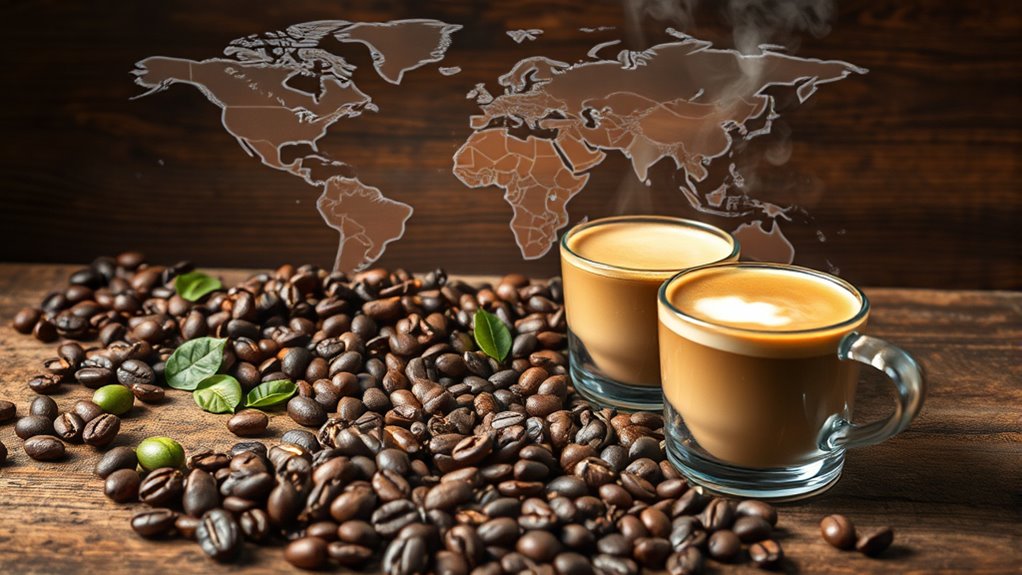
Different coffee varieties offer distinct flavor profiles, with Robusta and Arabica standing out as the most prominent. Their flavor nuances are shaped by bean processing and chemical composition. Robusta beans are rounder, with a strong, earthy, woody taste and a bitter edge, thanks to higher caffeine and chlorogenic acid levels. They produce a thicker crema, making them ideal for espresso and instant coffee. Arabica beans are oval, oilier, and sweeter, with fruity and zesty notes stemming from higher sugar and lipid content. Grown at higher altitudes, Arabica’s milder profile results from lower caffeine and unique bean processing techniques that preserve its delicate flavors. These differences influence your coffee experience, highlighting the contrasting qualities of each variety and their roles in brewing.
Climate Challenges and Sustainable Practices in Coffee Production
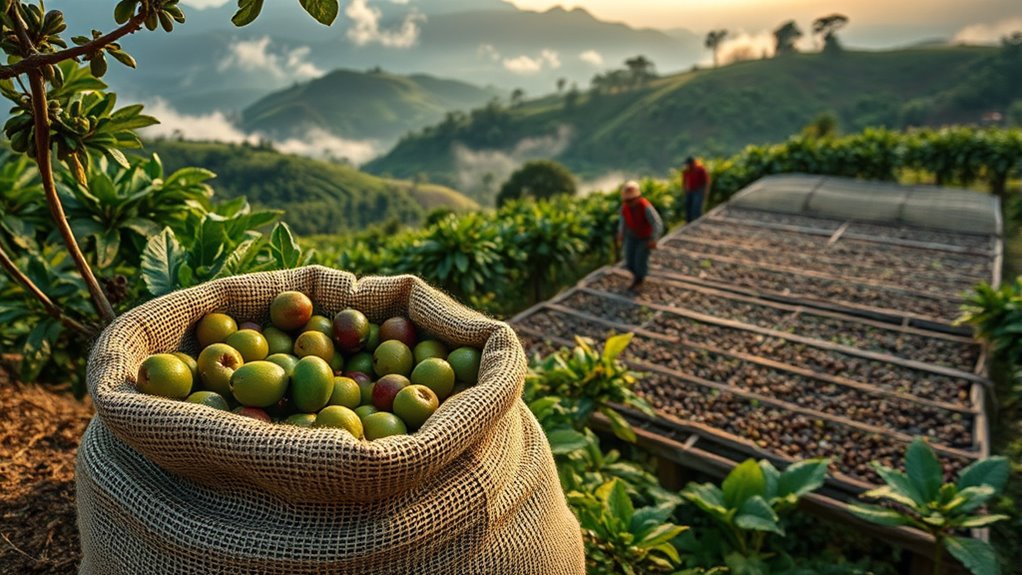
Climate change poses significant threats to coffee production, forcing growers to adapt quickly to shifting conditions. Rising temperatures shrink suitable growing areas, and farmers are increasingly practicing sustainable farming by shifting to higher elevations and adopting agroforestry with shade trees. Climate adaptation also involves breeding climate-resilient coffee varieties, utilizing wild Arabica genes, and improving water management to combat droughts and irregular rainfall. These measures help mitigate risks like pest outbreaks and soil erosion caused by extreme weather. Implementing integrated pest management strategies is also essential to reduce the impact of pests that thrive in warmer, wetter climates, further supporting sustainable coffee cultivation. Additionally, adopting climate-smart agriculture techniques can enhance resilience against the unpredictable effects of climate change and ensure long-term productivity.

You’ll find that major shipping hubs like Santos, Buenaventura, and Hai Phong play a vital role in moving coffee worldwide. Changes in trade volume, driven by demand shifts and logistical challenges, directly impact delivery times and costs. As trade routes adapt to new markets, understanding these dynamics helps you better navigate the global coffee landscape. Notably, with global exports projected to reach 122.3 million bags, the efficiency of these ports becomes even more critical for maintaining supply chain stability in response to rising demand. Incorporating innovative shipping techniques can further enhance the resilience and capacity of the coffee supply chain amidst these evolving trade routes.
Shipping Hubs and Routes
Ever wondered how coffee travels from lush plantations to your cup? It all starts with strategic shipping hubs that facilitate maritime logistics and guarantee compliance with shipping regulations. Major ports like Barcelona, Hamburg, and Santos serve as key entry and exit points, connecting coffee producers to global markets. These hubs handle massive container shipments, making transit smoother and more efficient. Shipping routes follow specific pathways—Brazil’s Atlantic route to Europe and North America, or Asian routes through the South China Sea. Cargo is often combined with rail or trucking, optimizing delivery times. Seasonal adjustments, port congestion, and geopolitical factors influence these routes. By streamlining maritime logistics and adhering to shipping regulations, these hubs keep coffee flowing seamlessly from farm to cup. Additionally, juice extraction techniques are employed at some processing points to maximize efficiency and preserve freshness during transit.
Trade Volume Fluctuations
Global coffee trade experiences significant fluctuations driven by changes in production, export volumes, and market demand. These export volume fluctuations are influenced by regional shifts, such as increased output in Vietnam and Ethiopia, contrasted with declines in Brazil and Colombia. Market price volatility reflects these shifts, with the International Coffee Organization’s index soaring over 90% in two years, creating uncertainty for exporters. Despite rising export volumes—Vietnam’s exports up 1.6 million bags—tight inventories at 22.8 million bags keep supply pressure high. Rising prices, like Vietnam’s export price reaching USD 5,705/ton, incentivize producers to invest domestically, affecting trade routes and export strategies. These dynamics shape global trade, prompting adjustments in export patterns to accommodate fluctuating volumes and prices.
Cultural Significance and Coffee Heritage in Local Communities
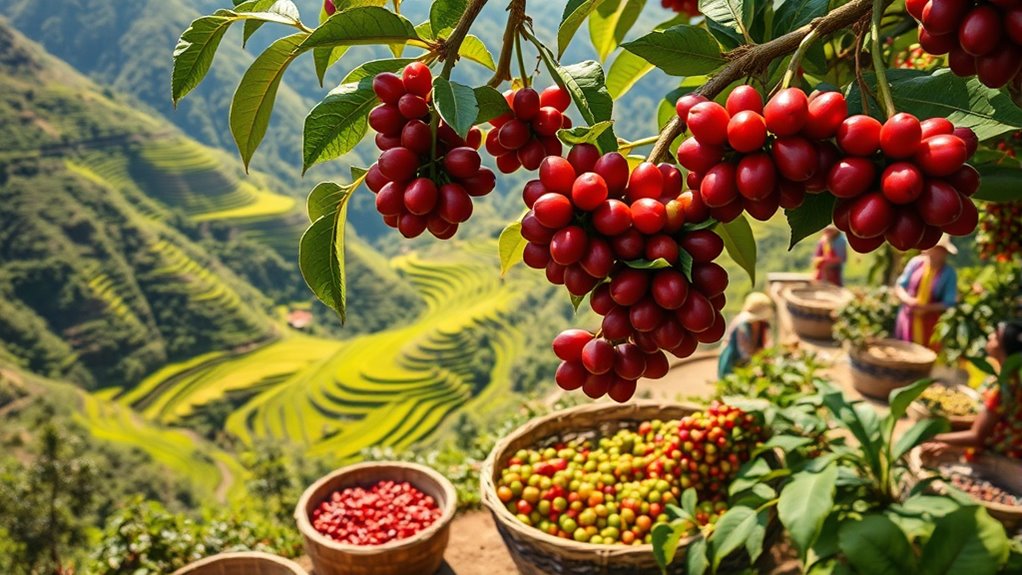
You can see how traditional coffee rituals strengthen community bonds and pass down cultural values. Festivals centered around coffee celebrate local heritage and bring people together to share their traditions. By preserving these practices, communities keep their unique coffee stories alive for future generations. Additionally, these cultural events can serve as a platform to educate visitors about coffee heritage, ensuring the legacy continues.
Traditional Coffee Rituals
Traditional coffee rituals serve as essential expressions of cultural identity and social cohesion within local communities. These ceremonies, like Ethiopia’s coffee ceremony, hold deep ritual significance, symbolizing hospitality, purification, and spiritual transformation. You might observe roasting green beans over charcoal, burning frankincense, or brewing coffee in a *jebena*. The process involves multiple rounds—Abol, Tona, and Bereka—each representing different stages of spiritual growth. Serving in small ceramic cups and offering sugar, salt, or butter reinforces community bonds and respect. These rituals aren’t just about coffee—they preserve cultural heritage and foster intergenerational connections. Additionally, color accuracy in the presentation of coffee—such as the rich, vibrant hues of freshly brewed coffee—is important for maintaining the visual appeal and authenticity of traditional beverages.
Community Coffee Festivals
Have you ever wondered how coffee festivals serve as vibrant celebrations of local culture and community identity? These events boost community engagement by gathering residents and visitors to share in the rich coffee heritage. They foster cultural celebrations through music, dance, and culinary activities that reflect local traditions. As you participate, you help strengthen social bonds, promote neighborhood pride, and support local artisans and vendors. Coffee festivals also create economic opportunities, increasing tourism revenue and opening markets for smallholder farmers. They serve as platforms for education on sustainable practices and industry innovations. International guests and experts bring global perspectives, enhancing cultural exchange. Additionally, these festivals often showcase specialty coffee and brewing techniques, highlighting the artistry involved in coffee production. Ultimately, these festivals celebrate the unique identity of coffee-producing regions, reinforcing their cultural significance and fostering a sense of unity within the community.
Local Heritage Preservation
Local communities actively preserve their coffee heritage by safeguarding cultural practices and landscapes that define their identity. Indigenous practices play a crucial role, with communities continuing traditional methods and maintaining deep links to ancestral lands. The Yanesha Indigenous in Peru, for example, incorporate rainforest knowledge into coffee cultivation, creating unique cultural identities. Heritage conservation efforts include protecting historical landscapes, such as Cuba’s first coffee plantations, and promoting sustainable farming. These initiatives often involve local participation, ensuring traditions remain alive through education and tourism. You might find that creativity can be cultivated through ongoing engagement and innovation to adapt traditional methods to modern challenges.
Frequently Asked Questions
How Do Smallholder Farmers Adapt to Climate Change Impacts?
To adapt to climate change impacts, you implement sustainable practices like agroforestry, organic inputs, and soil conservation to improve resilience. You adopt diversification strategies by growing different crops and integrating shade trees, which reduce risks and buffer income. Participating in community efforts and leveraging local knowledge help you develop tailored solutions. Support from organizations guarantees you access resources, strengthening your capacity to face changing weather patterns and maintain your livelihood.
What Innovations Are Emerging in Indonesian and Colombian Coffee Cultivation?
You’ll see that in Indonesian and Colombian coffee cultivation, innovative sustainable practices are key. Farmers are adopting crop diversification to improve resilience and soil health, while advanced techniques like precision agriculture and climate-smart varieties help combat climate change. These efforts boost productivity, quality, and sustainability, ensuring your coffee journey is supported by environmentally responsible methods. By embracing these innovations, both regions are strengthening their coffee industries for the future.
How Does Government Policy Influence Coffee Prices and Farmer Livelihoods?
You might notice how government policies, like export tariffs, directly impact coffee prices and farmer livelihoods. When tariffs increase, market speculation heats up, causing price volatility that hurts producers and consumers. These policies can reduce export volumes, squeezing farmers’ incomes and destabilizing local economies. As a result, the ripple effect threatens the entire supply chain, making it harder for farmers to thrive and for coffee lovers to enjoy affordable brews.
What Role Does Technology Play in Improving Coffee Quality and Yields?
You see, technology plays a essential role in boosting coffee quality and yields through precision agriculture and drone monitoring. With precision agriculture, you can optimize fertilization and watering, leading to healthier plants and better beans. Drone monitoring provides real-time insights into crop health and pest issues, allowing you to address problems early. These tools help you increase productivity, maintain consistent quality, and make more informed decisions for a sustainable, profitable coffee farm.
How Are Fair Trade and Certification Efforts Transforming Local Coffee Economies?
Fair trade and certification efforts transform your local coffee economy by empowering farmers with higher, guaranteed prices and better bargaining power. These initiatives boost community development, improve infrastructure, and promote economic diversification. While some intermediaries might see income declines, overall, fair trade reduces income inequality and increases household incomes. Certification also encourages sustainable practices, ensuring long-term productivity and resilience, ultimately benefiting everyone involved in your coffee’s journey.
Conclusion
As you explore the rich tapestry of coffee’s journey from Java to Colombia, you’ll find that each cup reflects more than just flavor—it embodies centuries of tradition, resilient landscapes, and shared stories. Embracing sustainable practices and honoring local heritage guarantees this beloved beverage continues to weave its gentle influence across cultures. In every sip, there’s a quiet reminder of the delicate balance required to keep this timeless journey thriving for generations to come.
